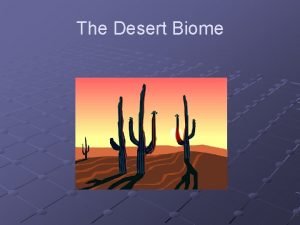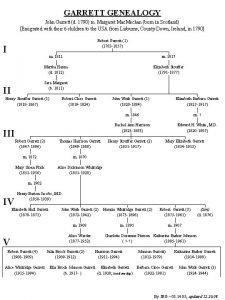The Desert Warthog Garrett Field Classification q The

















- Slides: 17

The Desert Warthog Garrett Field

Classification q The desert warthog’s animal kingdom belongs to the Animalia kingdom which is the taxonomic kingdom comprising of all animals to include even human beings q The desert warthog’s phylum is Chordata. q. The animal’s class is Mammalia and order is Artiodactyla. q. The desert warthog’s family genus is Suidae and species is P. Aethiopicus.

Physical Characteristics The size of the desert warthog is estimated to be in the range between 125 and 250 pounds because the males weigh a lot more than the females. Their width is approximately 30 inches at the shoulder and they stand about 3 -4 feet high. q Another interesting discovery is that they have rather long tails that can reach up to almost 20 inches long. q

Male VS Female

Distribution The desert warthog species is very widespread in several countries but mostly concentrated in several South African countries such as Eritrea, Kenya, Somalia, Ethiopia, and Djibouti. q Very little research has been conducted to get an accurate count on the population numbers of the desert warthog mainly because most of them can only be located mostly in remote villages in some of q

Map of Distribution The desert warthog species is very widespread in several countries but mostly concentrated in several South African countries such as Eritrea, Kenya, Somalia, Ethiopia, and Djibouti.

Habitat q. The desert warthogs try to live in flat, moist and arid savannas. q They like a place with an abundance of grass and weeds along with a place where there aren’t any other warthog families living there. q. Another interesting that I found was that sometimes more than one family can share a watering hole.

African Savanna Grassy Plain

Conservation Status q. At this time, the classification is listed as “least concern” in the IUCN Red List. q Sometimes over-grazing by domestic livestock and competition for water with humans and those domestic livestock could be affecting the populations of the desert warthogs in some regions but these estimates are subject to ongoing evaluations.

Reproduction Characteristics q. When it comes to the size differences between male and female desert warthogs, males can weigh about 20 -50 pounds more than a female. q. Male warthogs usually have warts below their eyes and also between their tusks. q. The male warthog has been known to join other groups during breeding season but afterwards will leave the groups until the next season.


Longevity and Mortality q. Other than some estimates that put the desert warthog’s longevity and mortality at about 15 years, more research needs to be done in order to get more accurate information. q. Desert warthog’s don’t hibernate but are known to make burrows like other animals that actually hibernate but that this is only for protection against predators and to protect their young.

Seasonal Patterns and Diet q“The main dietary habits of the desert warthog are that they are mainly grazers who eat grass but will eat grubs by diffing with their tusks. ” (Janssen) q. They prefer small grass and do so easily on their knees which appear to be designed specifically for those movements.

Predator and Human relationships q. The desert warthog’s main predators are lions and leopards. They defend themselves primarily by fleeing and hiding in their holes for sometimes a long period of time. q. Ever since humans started farming huge amounts of land in the plains of Africa, these animals have found ways to raid these farms plants and food sources. It is because of this that farmers have been

Fun Facts q. Very little research has been conducted to get an accurate count on the population numbers of the desert warthog mainly because most of them can only be located mostly in remote villages in some of these desolate countries. q“The pelage is coarse and usually very sparse, except for a prominent dorsal crest of long bristles. ” (Janssen) Normally in young animals especially, there is often a fringe of white hairs on their cheeks. “Another prominent pelage is that their knees are padded with a heavy skin which allows them to get on their knees and do such

VIDEO http: //www. youtube. com/watch? v=yn 08 x. J xh 3 c. A

Works Cited Janssen, Paul. "Warthog. " Out of Africa. N. p. , n. d. Web. 26 Feb. 2013. <http: //www. outofafrica. nl/animals/engwarthog. html>. Meijaard, E. , J. P. D'Huart, and W. L. Oliver. "LC - Desert Warthog. " Ed. D. E. Wilson and R. A. Mittermeier. Wild Pig Specialist Group. Lynx Edicions, 2011. Web. 26 Feb. 2013. <https: //sites. google. com/site/wildpigspecialistgroup/home/Phacoch oerus-aethiopicus>. Stoddart, D. M. "Aardvark and Pigs. " A Macmillan Illustrated Encyclopedia Animals: Mammals. Ed. Philip Whitfield. Vol. One. New York: Macmillan Library Reference USA, 1999. 154 -55. Print. "Warthog. " Wildlife of the World. Ed. Deborah Evans. Vol. 12. North Bellmore: Marshall Cavendish, 1994. 734 -35. Print.
 The soldier decided to desert his dessert in the desert
The soldier decided to desert his dessert in the desert Warthog horse
Warthog horse Springbok shot placement
Springbok shot placement Jesse james garrett visual vocabulary
Jesse james garrett visual vocabulary Garrett model of speech production
Garrett model of speech production Language production
Language production Garrett's model of speech production
Garrett's model of speech production Lexical ambiguity examples
Lexical ambiguity examples Garrett lee smith
Garrett lee smith Garrett wolfe duke
Garrett wolfe duke Garrett portable buildings
Garrett portable buildings Richard garrett ofqual
Richard garrett ofqual Garrett hardin
Garrett hardin Ohio inventions
Ohio inventions Garrett lee smith grant
Garrett lee smith grant Jesse james garrett
Jesse james garrett Child penis
Child penis Liv garrett
Liv garrett
































